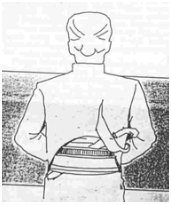|
|
|
S |
|
Sundang is a district of Sulu, Mindanao, in the Southern Philippines. The shape is similar to a Java Keris, the blade is much longer, approx. 53 cm and the ganja is 10.2 cm wide. A peculiarity of this keris is Kotik or the ring, which is found at the Kembang Kacang. The special handle is called Sarimaunk. The Dapur Sundang Keris is under-separates Sundang 3 Luk = Suluk Bali Kung, Sundang 5 Luk = Api Liang and Sundang 7 Luk and more = Rantai or Jenova. |
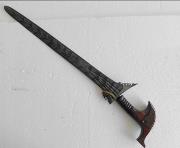
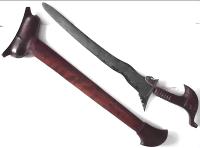

|
Sunggingan, Warangka is a warangka which is decorated with paintings after completion. These paintings are usually wayang kulit figures. |
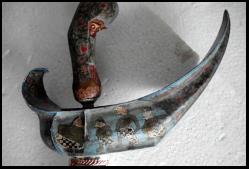
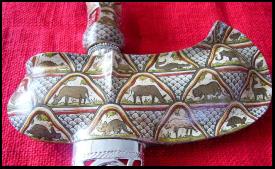
|
Sungkai, Kayu see Tremabalo wood. |
|
Sungkem or Sungkeman is the form of a Kembang Kacang. In Surakarta and Yogyakarta it is also called Kembang Kacang Nyunti or Ngecambah Aking. |
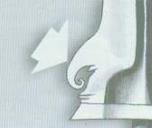
|
Sungkeman is a wearing method of a keris in Central Java. It is in the belt so that the entire gandar is covered from Sabuk (belt). The handle is rightward. So the Keris e.g. is worn at funerals. |
|
Sungon is made of two pieces of buffalo horn. In Javanese called Horn Sungu. These two buffalo horn pieces are connected with a small round wood. It is used for storage of blades. |
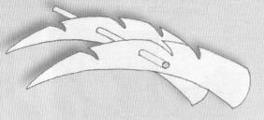
|
Supa, Empu Ki is a generic term for many Empu named Supa. These include Supa Mandrangi, Supagati, Supadriya, Supajaya, Supa Anom, Jaka Supa, Supawinangan and Supasetika. |
|
Supa Anom, Empu or short only Ki Nom is a known Empu from the territory Majapahit at the time of the Kingdom of Demak. |
|
Supadriya, Empu is a known Empu from Tuban at the era of the Kingdom of Majapahit. |
|
Supagati, Empu is a well-known Empu in the area Blambangan at the era of the Kingdom of Majapahit, about the end of the 12th century. |
|
Supajaya, Empu is a known Empu from Surakarta during the reign of Sultan Paku Buwono III. |
|
Supasetika, Ki Empu is a known Empu from Yogyakarta during the reign of Sri Sultan Hamengku Buwono VII. |
|
Supa Mandrangi, Empu is a known Empu in the era of Majapahit. He is also known as Pangeran Sedayu. His krisses always had many ornaments. |
|
Supa Winangun is a known Empu during the reigns of Sri Sultan Hamengku Buwono VII. and VIII, so in the 20th century. |
|
Supana Bener see Sepaner. |
|
Suparman Wignyosukadgo, Empu is a known Empu from Surakarta and lived from 1922 to 1991. |
|
Supiyanto is a known Empu from near Yogyakarta. He was born 1958. |

|
Sura Lasem, Kanjeng Kyai is a Pusaka Keris of the Kraton Yogyakarta. It is from Dapur Jalak and the warangka is made of Trembalo wood with a pendok made of 24 carat gold. |
|
Suratman, Empu is a well-known Empu in the area Tuban and lived in the era of Majapahit, around the 13th century. In some books, his name is also written Jaka Suratman. |
|
Surawisesa, Empu is a known Empu in the area of Blambangan and the older brother of Empu Ki Supa. |
|
Susuk or Susruk or Panggur is an auxiliary tool of the Empu to make a keris. It is made of steel and is used to design the surface of a blade used for making e.g. a Sraweyan or Tikel Alis. |

